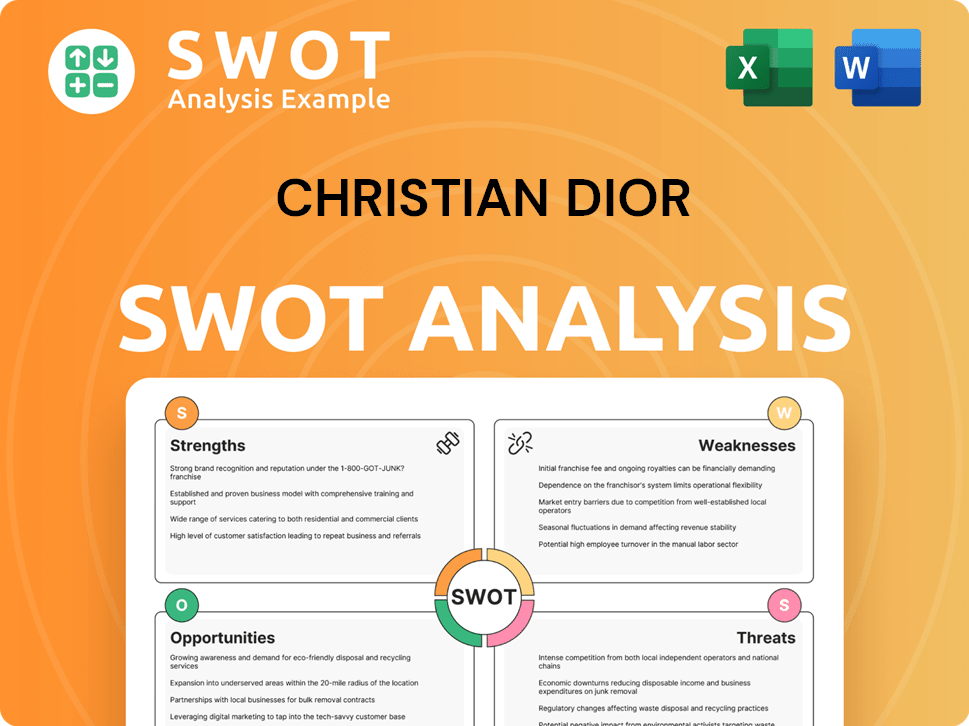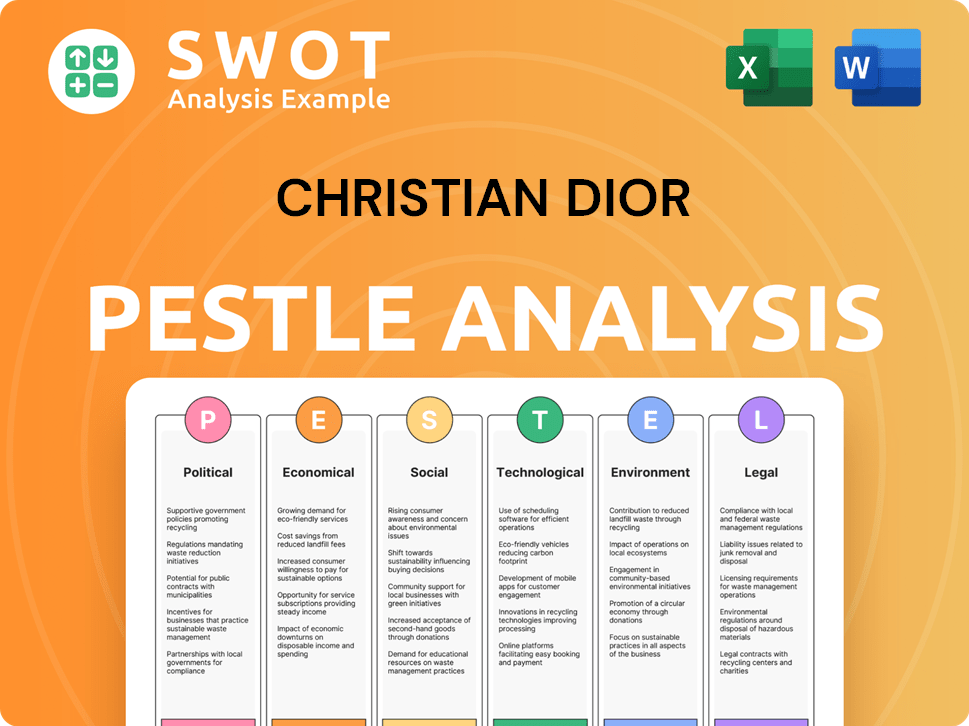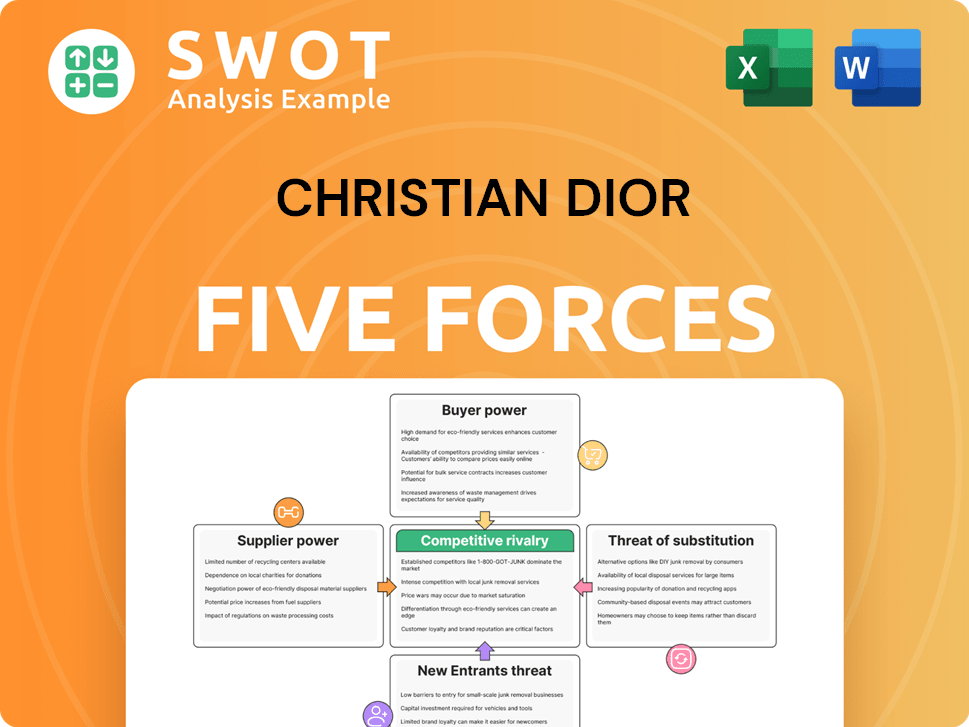Christian Dior Bundle
How Does Dior Dominate the Luxury Fashion Market?
Christian Dior, a name synonymous with elegance, has captivated the world since 1946. From the revolutionary 'New Look' to its current global presence, Dior has consistently set the standard for luxury. But how does this iconic brand maintain its allure and drive sales in an ever-evolving market?

This article will dissect Christian Dior SWOT Analysis, exploring its sophisticated sales and marketing strategies that have cemented its position in the luxury fashion world. We'll uncover Dior's innovative Dior marketing strategy, from its digital campaigns to its exclusive retail experiences, and analyze how it builds brand loyalty. Learn how Dior's brand strategy, including its approach to high-end retail sales and fashion brand positioning, contributes to its enduring success, and understand the impact of Dior's marketing on sales.
How Does Christian Dior Reach Its Customers?
The sales strategy of Christian Dior, a prominent player in the luxury fashion market, is multifaceted, leveraging both physical and digital channels to reach its global clientele. This approach, central to its Dior brand strategy, ensures a seamless brand experience across all touchpoints. The company's focus on exclusivity and personalized service is evident in its sales techniques, which are designed to cater to the discerning tastes of its customers.
Christian Dior's marketing strategy emphasizes a blend of direct-to-consumer (DTC) sales through its boutiques and online platforms, alongside strategic partnerships with select high-end retailers. This dual approach allows the brand to maintain control over its image while expanding its reach. The brand’s distribution channels and sales are carefully managed to uphold its luxury positioning.
Dior’s commitment to innovation is reflected in its substantial investments in both physical retail and digital platforms. In 2024, the company allocated a significant portion of its €5.5 billion operating investments to expand its store network and production facilities, with a notable €1.7 billion directed towards France. This strategic investment underscores the importance of physical retail in providing an immersive luxury experience, which is crucial for building brand loyalty.
Christian Dior operates flagship stores in major fashion capitals and boutiques in high-end shopping districts globally. These locations offer a personalized service, allowing customers to engage directly with the brand. The expansion of the store network is a key part of its high-end retail sales strategy.
The company’s e-commerce platforms and official website are vital for sales, providing a wide product selection to a global audience. Dior’s digital marketing campaigns are particularly effective in engaging younger, tech-savvy consumers. This approach supports Dior's e-commerce sales strategy.
Dior employs a selective distribution model to maintain exclusivity and brand image. While direct-to-consumer sales are paramount, partnerships with select high-end department stores are also utilized. This controlled distribution is a key element of Dior's brand strategy.
Dior's strategic shift toward omnichannel integration ensures a seamless customer journey across all touchpoints. This approach combines online and offline experiences to enhance customer engagement. This integrated approach is essential for modern luxury fashion marketing.
Dior's sales associates are trained to provide personalized service, enhancing the luxury experience. The brand focuses on building strong customer relationships through tailored interactions. Understanding Dior's target market is crucial for effective sales strategies.
- Personalized consultations and styling advice.
- Exclusive in-store events and private shopping experiences.
- Use of customer relationship management (CRM) systems to track preferences.
- Emphasis on product knowledge and storytelling to connect with customers.
Christian Dior SWOT Analysis
- Complete SWOT Breakdown
- Fully Customizable
- Editable in Excel & Word
- Professional Formatting
- Investor-Ready Format

What Marketing Tactics Does Christian Dior Use?
The marketing tactics employed by Christian Dior are multifaceted, designed to enhance brand awareness, drive demand, and boost sales. The company skillfully blends traditional prestige with innovative digital strategies. This approach ensures a strong presence across various platforms, connecting with consumers in meaningful ways.
Dior's marketing strategy is heavily reliant on digital platforms, especially social media, to showcase its products. Influencer collaborations and celebrity endorsements play a crucial role in expanding its reach. Data-driven marketing and customer segmentation are also key, creating tailored campaigns and personalized experiences.
The brand also uses traditional marketing methods, such as advertising campaigns in print media and participation in high-profile events. Experiential marketing through pop-up shops and exhibitions further enriches the customer experience. Augmented reality (AR) is integrated to enhance online engagement and drive sales.
Dior leverages social media platforms like Instagram and TikTok for visual storytelling. They engage consumers directly through immersive content. This approach is a core part of their Revenue Streams & Business Model of Christian Dior.
Collaborations with high-profile figures, such as Rihanna, amplify visibility. These partnerships often include exclusive content to boost engagement. This strategy is crucial for their luxury fashion marketing.
Dior uses data to create personalized experiences, such as the 'Dior Beauty Quiz'. This enhances customer engagement and drives product discovery. This targeted approach supports high-end retail sales.
High-profile advertising campaigns in print media and events like the Met Gala are essential. These generate significant media attention and social media buzz. This helps with fashion brand positioning.
Pop-up shops and art exhibitions offer immersive brand experiences. These enhance customer engagement and brand perception. This approach is part of their Dior marketing strategy.
AR is integrated for virtual try-ons, enhancing the customer experience online. This drives online engagement and sales. This is a key element of their Christian Dior sales strategy.
Dior's marketing strategy includes a blend of digital and traditional methods, focusing on customer engagement and brand prestige. Their approach is designed to enhance brand awareness and drive sales.
- Digital Marketing: Dior utilizes social media extensively, particularly Instagram and TikTok, for visual storytelling and direct consumer engagement.
- Influencer Marketing: Collaborations with celebrities and influencers, such as Rihanna, are used to amplify brand visibility and align with aspirational values.
- Data-Driven Marketing: Dior employs data analysis to create personalized customer experiences, such as the 'Dior Beauty Quiz'.
- Traditional Advertising: Print media campaigns and high-profile events like the Met Gala remain important for generating media attention.
- Experiential Marketing: Pop-up shops and art exhibitions offer immersive brand experiences.
- Augmented Reality (AR): AR technology is used to enhance the customer experience, particularly for virtual try-ons.
Christian Dior PESTLE Analysis
- Covers All 6 PESTLE Categories
- No Research Needed – Save Hours of Work
- Built by Experts, Trusted by Consultants
- Instant Download, Ready to Use
- 100% Editable, Fully Customizable

How Is Christian Dior Positioned in the Market?
The brand positioning of Christian Dior centers on timeless luxury, elegance, and innovation, setting it apart in the competitive high fashion industry. Dior's core message revolves around femininity, aspiration, and allure, aiming to represent an idealized vision of status and refined living. This is consistently maintained across all channels, from haute couture collections to fragrances and accessories. This approach is a key element of its Dior brand strategy.
Dior targets an affluent audience that values quality, exclusivity, and craftsmanship, viewing Dior products as status symbols. The brand strategically maintains high price points and offers limited editions to reinforce this sense of rarity and privilege, which is a key aspect of its luxury fashion marketing. Dior's commitment to innovation is evident in its continuous investment in research and development, especially in beauty and cosmetics, where it uses advanced skincare technologies and innovative packaging.
Dior's brand strategy is built on a foundation of heritage, dating back to 1946, while consistently reinventing itself to stay ahead of trends. The brand also emphasizes sustainability through initiatives like 'Dream in Green' and ethical sourcing, reflecting growing consumer concerns. This blend of tradition and modernity, coupled with quality storytelling and strategic partnerships, ensures Dior's enduring brand consistency and leadership in the luxury market.
Dior primarily targets affluent consumers who value luxury and exclusivity. These individuals seek high-quality products and are willing to pay a premium for them. This focus is a core part of their high-end retail sales approach.
The brand is associated with sophistication, glamour, and femininity. Dior emphasizes innovation in its products, particularly in beauty and cosmetics, using advanced technologies. These attributes are central to Dior's marketing strategy.
Dior uses a premium pricing strategy to maintain its exclusivity and brand image. High price points and limited editions reinforce the perception of luxury and value. This strategy is a key part of Dior's pricing strategy for luxury goods.
Dior utilizes a multi-channel distribution strategy, including flagship stores, select retailers, and e-commerce. This approach ensures a consistent brand experience and broad reach. Their distribution channels and sales are carefully managed.
Dior's digital marketing campaigns are known for their high production value and focus on storytelling. They often feature celebrities and influencers to reach a wider audience. These campaigns are a key element of their Dior marketing strategy.
- Dior's advertising budget is substantial, reflecting its commitment to brand promotion.
- Social media marketing strategy includes engaging content and collaborations.
- Public relations strategy focuses on creating positive brand image.
- Influencers are used strategically to promote products and reach new customers.
Dior's success is also driven by its ability to build brand loyalty through exceptional customer experiences and consistent messaging. For a deeper dive into Dior's overall business approach, including its sales and marketing strategies, consider reading about the Growth Strategy of Christian Dior.
Christian Dior Business Model Canvas
- Complete 9-Block Business Model Canvas
- Effortlessly Communicate Your Business Strategy
- Investor-Ready BMC Format
- 100% Editable and Customizable
- Clear and Structured Layout

What Are Christian Dior’s Most Notable Campaigns?
The marketing efforts of Christian Dior, a luxury fashion house, are pivotal to its brand success. The company employs a multifaceted approach, blending traditional luxury marketing with innovative digital strategies. These campaigns are designed to enhance brand visibility, engage a diverse audience, and reinforce its position in the luxury fashion market. This strategy is vital for maintaining its leadership and desirability in a competitive global market.
Dior’s marketing strategy focuses on several key areas, including high-profile celebrity endorsements, artistic collaborations, and robust digital campaigns. The brand leverages these strategies to create emotional connections with consumers and drive sales. This approach is carefully crafted to maintain its luxury image while appealing to a broad demographic.
The brand's success is evident in its financial performance. In 2023, the fashion and leather goods division, which includes Dior, saw a revenue increase, demonstrating the effectiveness of its marketing and sales strategies. This growth underscores the impact of Dior's strategic marketing initiatives.
Dior's fragrance campaigns are a cornerstone of its marketing strategy. The Sauvage fragrance consistently ranks as the world's best-selling, showcasing sustained market appeal. In 2024, Rihanna became the face of the J'adore fragrance, enhancing its visibility and aligning it with a global icon. These campaigns utilize high-profile endorsements and immersive storytelling.
The 'Dior Lady Art' project exemplifies Dior's commitment to art and creativity. This initiative involves collaborations with contemporary artists to reinterpret the iconic Lady Dior bag. These collaborations generate significant buzz among fashion enthusiasts and collectors. This reinforces the brand's image as a symbol of artistic innovation.
Dior's digital campaigns are crucial for engaging younger audiences. The 'Dior Icons Capsule Collection' uses platforms like TikTok and Xiaohongshu. These campaigns incorporate user-generated content and influencer collaborations. This drives excitement and increases brand awareness.
Celebrity endorsements play a significant role in Dior's marketing strategy. High-profile celebrities, like Rihanna, are chosen to represent the brand. These endorsements help to create an emotional connection with consumers. They also reinforce Dior’s luxury image.
Dior's marketing strategy integrates several key elements to maintain its market leadership. These elements work together to create a cohesive brand experience. This approach supports the brand's global presence and desirability.
- Celebrity Partnerships: Leveraging high-profile figures to enhance brand visibility.
- Artistic Collaborations: Engaging with contemporary artists to elevate brand prestige.
- Digital Engagement: Utilizing social media and digital platforms for wider reach.
- Luxury Positioning: Maintaining a premium brand image through exclusive experiences.
Christian Dior Porter's Five Forces Analysis
- Covers All 5 Competitive Forces in Detail
- Structured for Consultants, Students, and Founders
- 100% Editable in Microsoft Word & Excel
- Instant Digital Download – Use Immediately
- Compatible with Mac & PC – Fully Unlocked

Related Blogs
- What are Mission Vision & Core Values of Christian Dior Company?
- What is Competitive Landscape of Christian Dior Company?
- What is Growth Strategy and Future Prospects of Christian Dior Company?
- How Does Christian Dior Company Work?
- What is Brief History of Christian Dior Company?
- Who Owns Christian Dior Company?
- What is Customer Demographics and Target Market of Christian Dior Company?
Disclaimer
All information, articles, and product details provided on this website are for general informational and educational purposes only. We do not claim any ownership over, nor do we intend to infringe upon, any trademarks, copyrights, logos, brand names, or other intellectual property mentioned or depicted on this site. Such intellectual property remains the property of its respective owners, and any references here are made solely for identification or informational purposes, without implying any affiliation, endorsement, or partnership.
We make no representations or warranties, express or implied, regarding the accuracy, completeness, or suitability of any content or products presented. Nothing on this website should be construed as legal, tax, investment, financial, medical, or other professional advice. In addition, no part of this site—including articles or product references—constitutes a solicitation, recommendation, endorsement, advertisement, or offer to buy or sell any securities, franchises, or other financial instruments, particularly in jurisdictions where such activity would be unlawful.
All content is of a general nature and may not address the specific circumstances of any individual or entity. It is not a substitute for professional advice or services. Any actions you take based on the information provided here are strictly at your own risk. You accept full responsibility for any decisions or outcomes arising from your use of this website and agree to release us from any liability in connection with your use of, or reliance upon, the content or products found herein.